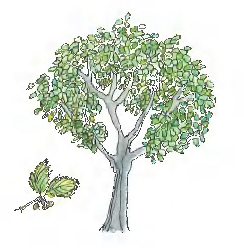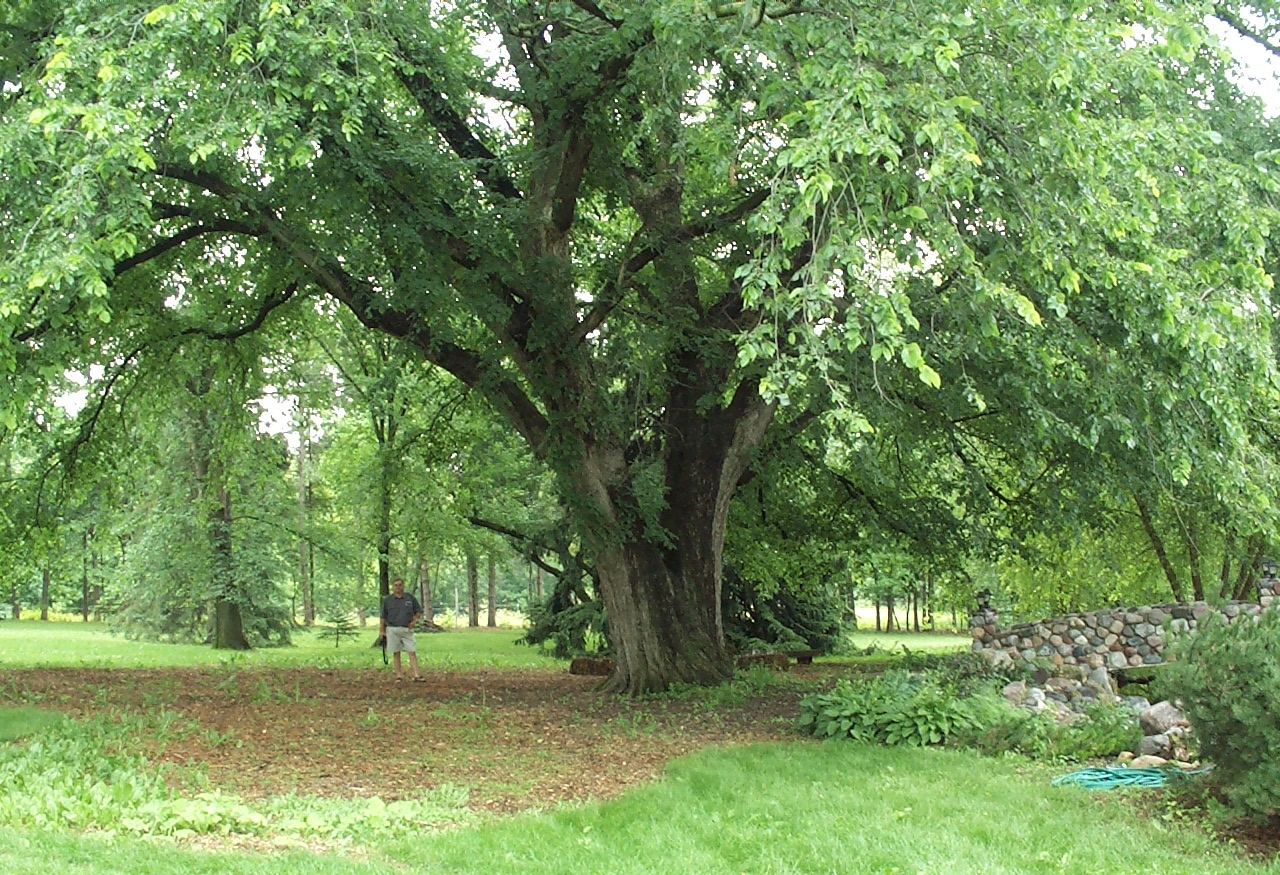
Thirty years ago the American elms with their vase-like form arched gracefully over nearly every urban street in Minnesota. The green canopy created shade and cooled the road, while providing homes for birds and food for butterflies and moths. The high leafy cathedrals added elegance. Elms were favored for their fast growth, longevity, and adaptability to many sites. They grow well in the urban environment with its air pollution, road salt, and compacted soil. Indeed, many individuals and towns considered the American elm “the perfect tree.” Native throughout the state and tolerant of our hot summers and cold winters, elms were planted in backyards and on boulevards.
Unfortunately, this monoculture created the perfect conditions for disease to thrive. Dutch Elm Disease (DED) entered the U.S. in 1930 on a shipment of logs from Europe. It spread rapidly through the country and was diagnosed in Minnesota in 1961. The disease is caused by the deadly Ophiostoma ulmi fungus and spread by bark beetles, both native and European. Beetles get inside the bark and infect the tree, blocking the tree’s water conducting system. The disease can be transmitted as beetles move from tree to tree. It can also be passed from root to root when trees are planted closely together, as on a boulevard. And though the peak of the crisis is behind us, DED is still a serious problem with any remaining trees.
It is estimated that only 1 in 100,000 American elm is DED-tolerant. Before Dutch elm disease hit, Minnesota had over 140 million elms. As the disease peaked here in the 1980s, trees yellowed and weakened in waves, leaving few elms in the urban environment. A fair number of elms (perhaps 1 million) survive still in woodlands as well as suburbs and cities. Most of these are small to medium-sized trees which were relatively isolated from other elms so not exposed to the disease. However, there is work on two fronts to restore elms to the landscape. Individuals and institutions can protect the remaining trees with two preventative fungicides (Alamo and Arbotect) injected into the base of the tree. Though not a guarantee, the treatments can provide a one to three more years. In addition, scientists are testing American elms for natural DED resistance and breeding cultivars from those strains.
Plant breeding has focused on three areas of research: development of resistant American elms, development of Asian species with desirable characteristics, and development of various elm hybrids. Research is ongoing at the University of Minnesota’s Horticulture Department as well as at the University of Wisconsin and the Morton Arboretum in Wisconsin. The U.S. National Arboretum and USDA Forest Service Forestry Services Laboratory, Northern Research Station (NRS) at Delaware, Ohio are other prime research locations in this country.
In 2011 the U.S. Forest Service NRS launched an on-line system for reporting the locations of American elm tree “survivors.” Within the first few weeks of its operation, individuals in five states reported the locations of 40 trees. The NRS will use these trees in their study of resistance to DED.
At the University of Minnesota, the Teaching, Research, and Extension (TRE) Nursery staff in cooperation with the Minneapolis Park and Recreation Board’s Forestry Division, are working to evaluate and select elms for use in Minnesota. In searching through the state’s remaining elms, they have selected hundreds, cloned many of them, planted them out, and injected them with the DED pathogen. Those that survive are tested over a period of 1o years. Chad Giblin, scientist with the Horticultural Science Department, noted that several cultivars should be ready for commercial trade in the near future. Shown below is the DED resistant St Croix elm.

Already there are cultivars with good levels of disease tolerance. Among American elms, one can choose ‘Valley Forge’, and ‘New Harmony’, both developed at the U.S.D.A. National Arboretum, as well as ‘Princeton,’ an older, but very resistant cultivar. Hybrids developed at Morton Arboretum in Wisconsin include ‘Accolade’, ‘Commendation,’ and ‘Triumph.’ see this complete list.
There are good reasons to save our elms. Besides their beauty and longevity, elms are forgiving trees. They can survive the hazards of city life—compacted soil, neglect, salt. Elms will grow happily in moist areas (they are often found growing naturally in bottomlands), but can survive drought that is not prolonged or severe. In the wild they are found in many soil types—well-drained sands, organic bogs, poorly drained clay, prairie loam, and many intermediate types. Elms are tolerant of limb and root pruning. Elms, as well as other trees, add monetary value to the landscape—private or civic.
Their value appreciates as they mature. Experts estimate that a tree adds 10 to 23% to the value of a residence. According to a study by the U.S. Forest Service, they provide assets three times their investment. (See chart below)
Value of Shade Trees:
1 Healthy Tree (20 years after planting) Per Year
| Benefits: | $44 |
| Costs: | $14 |
| Annual net: | $31 |
100 Healthy Trees (during 40 years growth)
| Yard | Public | |
| Benefits: | $364,000 | $380,000 |
| Costs: | $92,000 | $148,000 |
| Net Benefit: | $272,000 | $232,000 |
Based on U.S. Forest Service Tree Survey.
Elms and other trees cool homes, offices, and streets, reducing power generation emissions. Their leaves improve air quality by absorbing ozone, nitrogen dioxide, and some particulate matter; their roots absorb pollutants from the soil and transform them into less harmful substances. Elms and other trees reduce storm water runoff by capturing and storing rainfall in the leaves and releasing water into the atmosphere through evapotranspiration.
The Forest That Time Forgot
On 150 acres just south of the town of Kandiyohi, stands an old-growth forest with all the native species of Upper Midwest elms—red, rock, and American. These trees, many of them hundreds of years old, are thriving despite the presence of DED in the area. Occasionally there will be a dead elm; but close by others remain unscathed by the disease. New elms continue to sprout across the property. The land, Reid Woods, is owned by Dr. William and Ute Reid, who have carefully preserved the forest since acquiring the property in the 1960s. Forestry experts, including Dr. Lee Frelich, research and associate director of the University of Minnesota Center for Hardwood Ecology, and Mark Stennes, plant pathologist with S & S Tree Specialists, have examined the site. The reasons for this forest’s survival are complex and mysterious, they believe. “The probability of natural genetic resistance appearing in all three species on one site at one time,” wrote Stennes in the Minnesota Plant Press, “without evolutionary exposure to the pathogen, is fundamentally zero, to how are the trees surviving?” The two postulate that the combination of factors may include pests or parasites of the insect vector as well as fungus competition or suppression and/ or disease of the pathogen. It may be a testament to the innate health of virgin forests, Frelich concluded.
Elms and the Environment
Elms are native throughout Minnesota and grow in a variety of situations. They add diversity to the deciduous forests. Even today they make up 30% of the state’s forest trees. From Minnesota’s experience with Dutch elm disease, foresters and others in the state have learned the importance of diversity in the urban landscape as well. When DED first arrived, people made the assumption that our very cold climate would prevent beetles from surviving and so prevent the disease from taking hold. They were slow to enact prevention measures and allowed the disease to wipe out large portions of the urban forest. City foresters no longer plant one type of tree throughout our towns and cities, but strive to plant numerous species.
The leaves of the American elm are food for a variety of larvae of butterflies (Question Mark, Eastern Comma, Mourning cloak, Tawny emperor, to name a few). The tree is used by many birds for nesting. Cavity dwellers, such as woodpeckers, chickadees, squirrels, and raccoons often find homes here. Other birds—cardinals, sparrows, Baltimore orioles and others—build their nests among the branches. These animals and others feed on the fruits, seeds, and bark.
Along with other trees, elms cool the landscape, remove pollutants from the soil and from the air, and slow rainfall runoff. The cooling effect of one mature urban elm is said to be equivalent to five air conditioning units.
Did You Know? Fun Facts
- The scientific name for American elm is Ulmus americana.
- Other names for the tree are soft elm, water elm and white elm.
- The Iroquois used elm bark to make canoes, ropes, and utensils.
- A strong wood, it was also used for ship decks and wagon wheel hubs.
- The wood is prized by piano and furniture makers for its strength, weight and toughness and is commonly used in making hockey sticks because it can bend without splitting.
- Under ideal conditions the American elm can live for 300 years.
- American elms can reach over 100 feet tall and 4 feet in diameter.
- George Washington is said to have taken command of the American Continental Army under the Washington Elm in Cambridge, Massachusetts on July 3, 1775.
- Elm trees first appeared in the Miocene period, about 40 million years ago.
- Dutch elm disease got its name because it was discovered by scientists in Holland in 1917.
For more information see the 10 Plants That Changed Minnesota MSHS book.